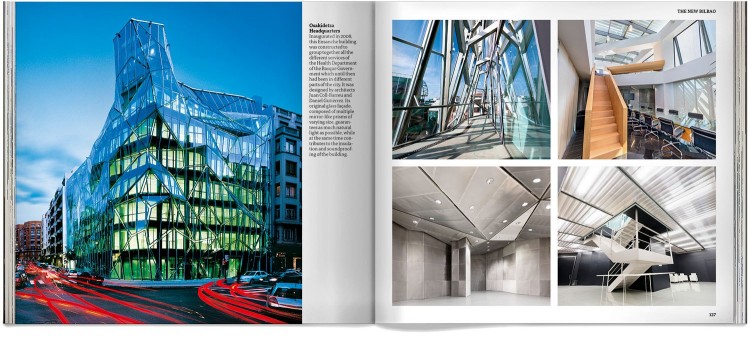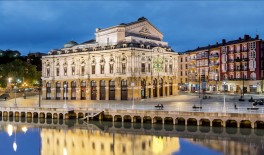Bilbao
A city in constant evolution
RETURN
About the book Bilbao
This book on Bilbao goes on a complete photographic journey around the most important zones and monuments in the city. When turning its pages, the reader will find out about the essential places to visit and discover the art, architecture and beauty of this exceptional city.
The more than 190 photographs of Bilbao included in this book published by Dosde show in detail the artistic and architectonic wealth of the Basque city, which attracts thousands of visitors each year. The pictures of Bilbao and texts cover the historical evolution of the municipality and the origins of its most emblematic monuments.
In order to provide a general view of the city, the book's chapters are divided up into different zones. Thus, the book explores the distinguishing elements of spaces such as the Old Quarter, the Arenal and Abandoibarra. Likewise, the book also provides an insight into nearby towns such as Getxo and Portugalete, closely linked to Bilbao's history. All in all, it is a comprehensive graphical testimony of a city that has been constantly evolving since its foundation.
The more than 190 photographs of Bilbao included in this book published by Dosde show in detail the artistic and architectonic wealth of the Basque city, which attracts thousands of visitors each year. The pictures of Bilbao and texts cover the historical evolution of the municipality and the origins of its most emblematic monuments.
In order to provide a general view of the city, the book's chapters are divided up into different zones. Thus, the book explores the distinguishing elements of spaces such as the Old Quarter, the Arenal and Abandoibarra. Likewise, the book also provides an insight into nearby towns such as Getxo and Portugalete, closely linked to Bilbao's history. All in all, it is a comprehensive graphical testimony of a city that has been constantly evolving since its foundation.
Photo Edition
Bilbao
It includes exclusive digital content
Made with environmentally friendly paper
Multilanguage: Available in 5 languages
More than 190 top quality photographs
About the book Bilbao
This book on Bilbao goes on a complete photographic journey around the most important zones and monuments in the city. When turning its pages, the reader will find out about the essential places to visit and discover the art, architecture and beauty of this exceptional city.
The more than 190 photographs of Bilbao included in this book published by Dosde show in detail the artistic and architectonic wealth of the Basque city, which attracts thousands of visitors each year. The pictures of Bilbao and texts cover the historical evolution of the municipality and the origins of its most emblematic monuments.
In order to provide a general view of the city, the book's chapters are divided up into different zones. Thus, the book explores the distinguishing elements of spaces such as the Old Quarter, the Arenal and Abandoibarra. Likewise, the book also provides an insight into nearby towns such as Getxo and Portugalete, closely linked to Bilbao's history. All in all, it is a comprehensive graphical testimony of a city that has been constantly evolving since its foundation.
The more than 190 photographs of Bilbao included in this book published by Dosde show in detail the artistic and architectonic wealth of the Basque city, which attracts thousands of visitors each year. The pictures of Bilbao and texts cover the historical evolution of the municipality and the origins of its most emblematic monuments.
In order to provide a general view of the city, the book's chapters are divided up into different zones. Thus, the book explores the distinguishing elements of spaces such as the Old Quarter, the Arenal and Abandoibarra. Likewise, the book also provides an insight into nearby towns such as Getxo and Portugalete, closely linked to Bilbao's history. All in all, it is a comprehensive graphical testimony of a city that has been constantly evolving since its foundation.
Images Bilbao
Videos Bilbao
No reviews yet.
Additional Information
- Additional Information
- Subtitle: A city in constant evolution
- Weight (g): 420
- Binding: Paperback with flaps
- Size (cm): 19,5 x 17,5
- Author: Dosde
- Pages: 0
- Edition: Photo Edition
What to see in Bilbao?
Founded at the beginning of the fourteenth century, Bilbao became one of the most important ports in the Middle Ages thanks to its strategic position on a meander on the left bank of the Nervión Estuary.
Maritime and commercial activity boosted the urban development of the town, which from the nineteenth century experienced an unprecedented boom due to the effects of industrialisation. During this period some of the most emblematic buildings of the city were built, which currently coexist with vestiges of the medieval era and fine examples of contemporary architecture.
Considered a reference model of urban renewal, Bilbao has joined the twenty-first century as a vibrant and cosmopolitan metropolis, capable of combining tradition with maximum modernity.
Without renouncing its unique personality and its long history, which dates back to medieval times, the city has successfully adapted to its new economic and social context, wagering on the most advanced architecture and the implementation of ambitious urban developments aimed at bringing out the potential of a city that is admired throughout the world.
From the second half of the 19th century, the centre of Bilbao moved to the Ensanche, the new urban area on the left bank of the river to deal with the strong population growth caused by industrialisation.
Made up of big streets and geometrically shaped avenues, the Ensanche is a fine example of the splendour of industrial Bilbao by means of its sumptuous buildings such as the Palacio de la Diputación Foral of Biscay and the Chávarri Palace, which reflect the bourgeoisie's taste at the time.
The main symbol of this transformation is the Guggenheim Museum Bilbao, converted into a landmark of contemporary architecture. Designed by the prestigious North American architect Frank O. Gehry, the building was inaugurated in 1997, and since then has been one of the most international emblems of Bilbao.
The Torre Iberdrola, the Euskalduna Palace and the Isozaki Atea are other buildings that symbolise the unstoppable modernisation process experienced by Bilbao over recent years, coinciding with its consolidation as a first class economic hub.
Maritime and commercial activity boosted the urban development of the town, which from the nineteenth century experienced an unprecedented boom due to the effects of industrialisation. During this period some of the most emblematic buildings of the city were built, which currently coexist with vestiges of the medieval era and fine examples of contemporary architecture.
Considered a reference model of urban renewal, Bilbao has joined the twenty-first century as a vibrant and cosmopolitan metropolis, capable of combining tradition with maximum modernity.
Without renouncing its unique personality and its long history, which dates back to medieval times, the city has successfully adapted to its new economic and social context, wagering on the most advanced architecture and the implementation of ambitious urban developments aimed at bringing out the potential of a city that is admired throughout the world.
The Old Quarter
Photos of Bilbao at its most traditional are often set in Siete Calles, the urban area corresponding to the medieval city. Here are the oldest buildings in Bilbao, such as the Cathedral, the Arana Palace, the bridge and San Antón Church, as well as some of the most popular restaurants and businesses. As well as Siete Calles, the historical centre encompasses the medieval neighbourhoods that arose just outside the walls, where today La Plaza Nueva and the Teatro Arriaga are found.
The Ensanche
From the second half of the 19th century, the centre of Bilbao moved to the Ensanche, the new urban area on the left bank of the river to deal with the strong population growth caused by industrialisation.Made up of big streets and geometrically shaped avenues, the Ensanche is a fine example of the splendour of industrial Bilbao by means of its sumptuous buildings such as the Palacio de la Diputación Foral of Biscay and the Chávarri Palace, which reflect the bourgeoisie's taste at the time.
The new Bilbao
Around the late 20th century, the decline of the industrial sector led to an ambitious urban development project in Bilbao. The local government promoted different projects that allowed the complete regeneration of the estuary and breathed new life into the spaces that had been formerly occupied by factories and shipyards. The change was so radical that photos of Bilbao taken before the renovation work are now practically unrecognisable.The main symbol of this transformation is the Guggenheim Museum Bilbao, converted into a landmark of contemporary architecture. Designed by the prestigious North American architect Frank O. Gehry, the building was inaugurated in 1997, and since then has been one of the most international emblems of Bilbao.
The Torre Iberdrola, the Euskalduna Palace and the Isozaki Atea are other buildings that symbolise the unstoppable modernisation process experienced by Bilbao over recent years, coinciding with its consolidation as a first class economic hub.




























